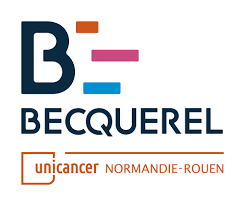Correlation Between FDG Hotspots on Pre-radiotherapy PET/CT and Areas of HNSCC Local Relapse : Impact of Treatment Position and Images Registration Method
Résumé
Aim: Several series have already demonstrated that intratumoral subvolumes with high tracer avidity (hotspots) in 18F-flurodesoxyglucose positron-emission tomography (FDG-PET/CT) are preferential sites of local recurrence (LR) in various solid cancers after radiotherapy (RT), becoming potential targets for dose escalation. However, studies conducted on head and neck squamous cell carcinoma (HNSCC) found only a moderate overlap between pre- and post-treatment subvolumes. A limitation of these studies was that scans were not performed in RT treatment position (TP) and were coregistred using a rigid registration (RR) method. We sought to study (i) the influence of FDG-PET/CT acquisition in TP and (ii) the impact of using an elastic registration (ER) method to improve the localization of hotpots in HNSCC. Methods: Consecutive patients with HNSCC treated by RT between March 2015 and September 2017 who underwent FDG-PET/CT in TP at initial staging (PETA) and during follow-up (PETR) were prospectively included. We utilized a control group scanned in non treatment position (NTP) from our previous retrospective study. Scans were registered with both RR and ER methods. Various sub-volumes (AX; x = 30, 40, 50, 60, 70, 80, and 90%SUVmax) within the initial tumor and in the subsequent LR (RX; x = 40 and 70%SUVmax) were overlaid on the initial PET/CT for comparison [Dice, Jaccard, overlap fraction = OF, common volume/baseline volume = AXnRX/AX, common volume/recurrent volume = AXnRX/RX]. Results: Of 199 patients included, 43 (21.6%) had LR (TP = 15; NTP = 28). The overlap between A30, A40, and A50 sub-volumes on PETA and the whole metabolic volume of recurrence R40 and R70 on PETR showed moderate to good agreements (0.41-0.64) with OF and AXnRX/RX index, regardless of registration method or patient position. Comparison of registration method demonstrated OF and AXnRX/RX indices (x = 30% to 50%SUVmax) were significantly higher with ER vs. RR in NTP (p < 0.03), but not in TP. For patient position, the OF and AXnRX/RX indices were higher in TP than in NTP when RR was used with a trend toward significance, particularly for x=40%SUVmax (0.50±0.22 vs. 0.31 ± 0.13, p = 0.094). Conclusion: Our study suggested that PET/CT acquired in TP improves results in the localization of FDG hotspots in HNSCC. If TP is not possible, using an ER method is significantly more accurate than RR for overlap estimation.
| Origine | Publication financée par une institution |
|---|
